Nike Supply Chain Management Analysis
VerifiedAdded on 2020/04/13
|13
|2809
|158
AI Summary
This assignment examines Nike's supply chain management practices, highlighting key decisions, successes, and challenges. It delves into historical events like the 'Nike Rebounds' case, explores operational aspects outlined by Ferguson (2017), and discusses the company's global manufacturing strategies. The analysis draws on various sources including academic journals, industry reports, and expert opinions to provide a comprehensive understanding of Nike's supply chain operations.
Contribute Materials
Your contribution can guide someone’s learning journey. Share your
documents today.
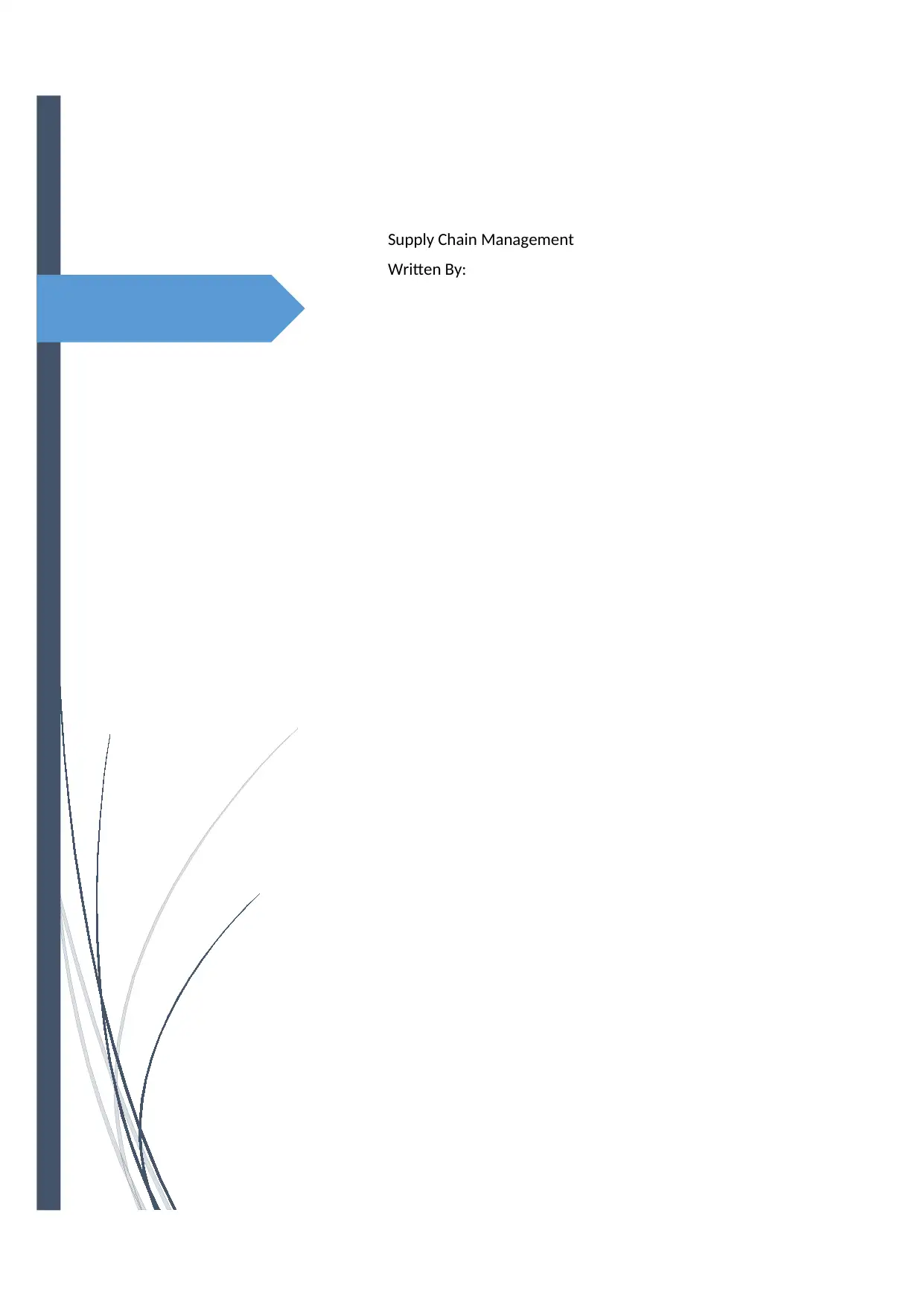
11/17/2017
Supply Chain Management
Written By:
Supply Chain Management
Written By:
Secure Best Marks with AI Grader
Need help grading? Try our AI Grader for instant feedback on your assignments.
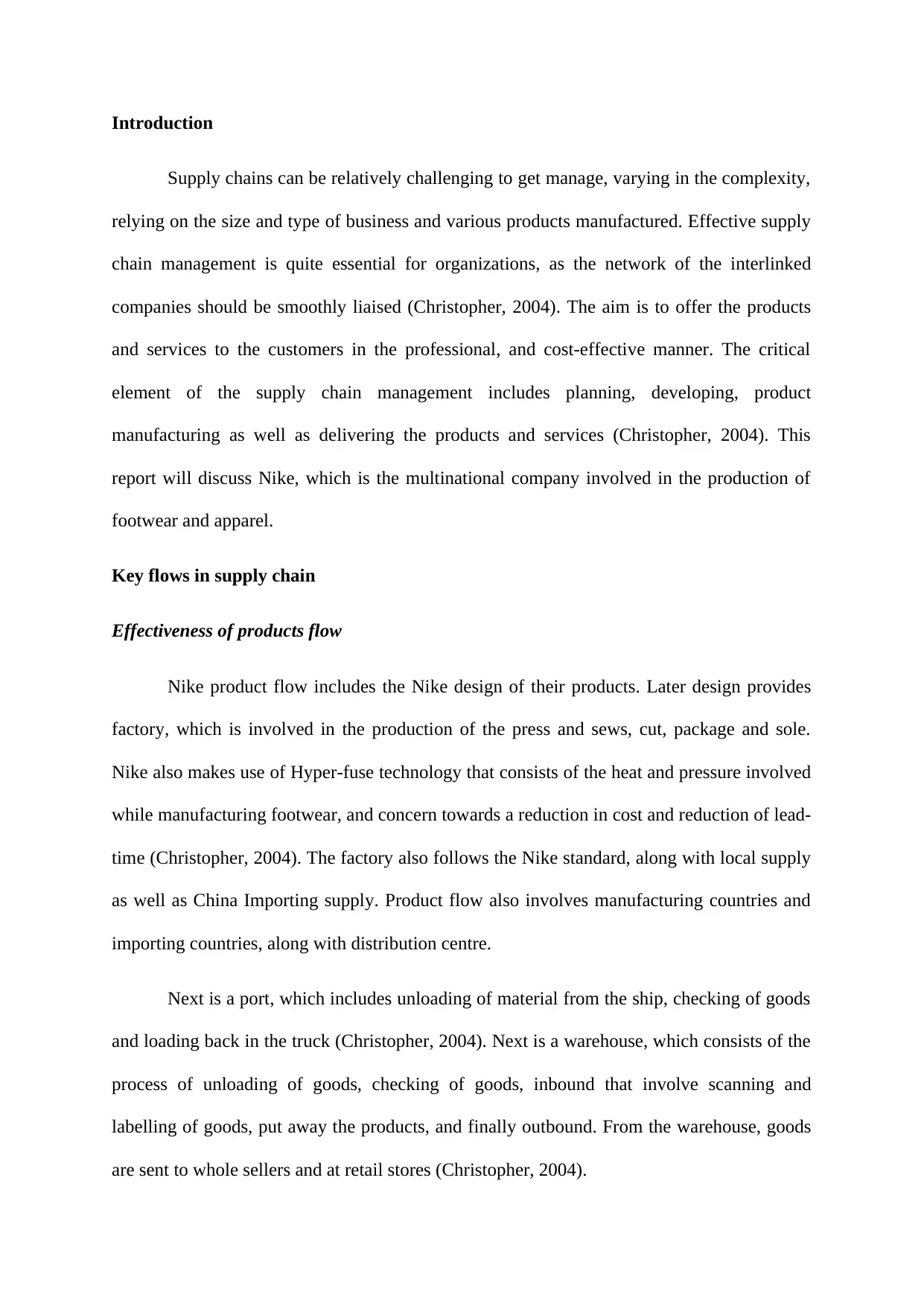
Introduction
Supply chains can be relatively challenging to get manage, varying in the complexity,
relying on the size and type of business and various products manufactured. Effective supply
chain management is quite essential for organizations, as the network of the interlinked
companies should be smoothly liaised (Christopher, 2004). The aim is to offer the products
and services to the customers in the professional, and cost-effective manner. The critical
element of the supply chain management includes planning, developing, product
manufacturing as well as delivering the products and services (Christopher, 2004). This
report will discuss Nike, which is the multinational company involved in the production of
footwear and apparel.
Key flows in supply chain
Effectiveness of products flow
Nike product flow includes the Nike design of their products. Later design provides
factory, which is involved in the production of the press and sews, cut, package and sole.
Nike also makes use of Hyper-fuse technology that consists of the heat and pressure involved
while manufacturing footwear, and concern towards a reduction in cost and reduction of lead-
time (Christopher, 2004). The factory also follows the Nike standard, along with local supply
as well as China Importing supply. Product flow also involves manufacturing countries and
importing countries, along with distribution centre.
Next is a port, which includes unloading of material from the ship, checking of goods
and loading back in the truck (Christopher, 2004). Next is a warehouse, which consists of the
process of unloading of goods, checking of goods, inbound that involve scanning and
labelling of goods, put away the products, and finally outbound. From the warehouse, goods
are sent to whole sellers and at retail stores (Christopher, 2004).
Supply chains can be relatively challenging to get manage, varying in the complexity,
relying on the size and type of business and various products manufactured. Effective supply
chain management is quite essential for organizations, as the network of the interlinked
companies should be smoothly liaised (Christopher, 2004). The aim is to offer the products
and services to the customers in the professional, and cost-effective manner. The critical
element of the supply chain management includes planning, developing, product
manufacturing as well as delivering the products and services (Christopher, 2004). This
report will discuss Nike, which is the multinational company involved in the production of
footwear and apparel.
Key flows in supply chain
Effectiveness of products flow
Nike product flow includes the Nike design of their products. Later design provides
factory, which is involved in the production of the press and sews, cut, package and sole.
Nike also makes use of Hyper-fuse technology that consists of the heat and pressure involved
while manufacturing footwear, and concern towards a reduction in cost and reduction of lead-
time (Christopher, 2004). The factory also follows the Nike standard, along with local supply
as well as China Importing supply. Product flow also involves manufacturing countries and
importing countries, along with distribution centre.
Next is a port, which includes unloading of material from the ship, checking of goods
and loading back in the truck (Christopher, 2004). Next is a warehouse, which consists of the
process of unloading of goods, checking of goods, inbound that involve scanning and
labelling of goods, put away the products, and finally outbound. From the warehouse, goods
are sent to whole sellers and at retail stores (Christopher, 2004).
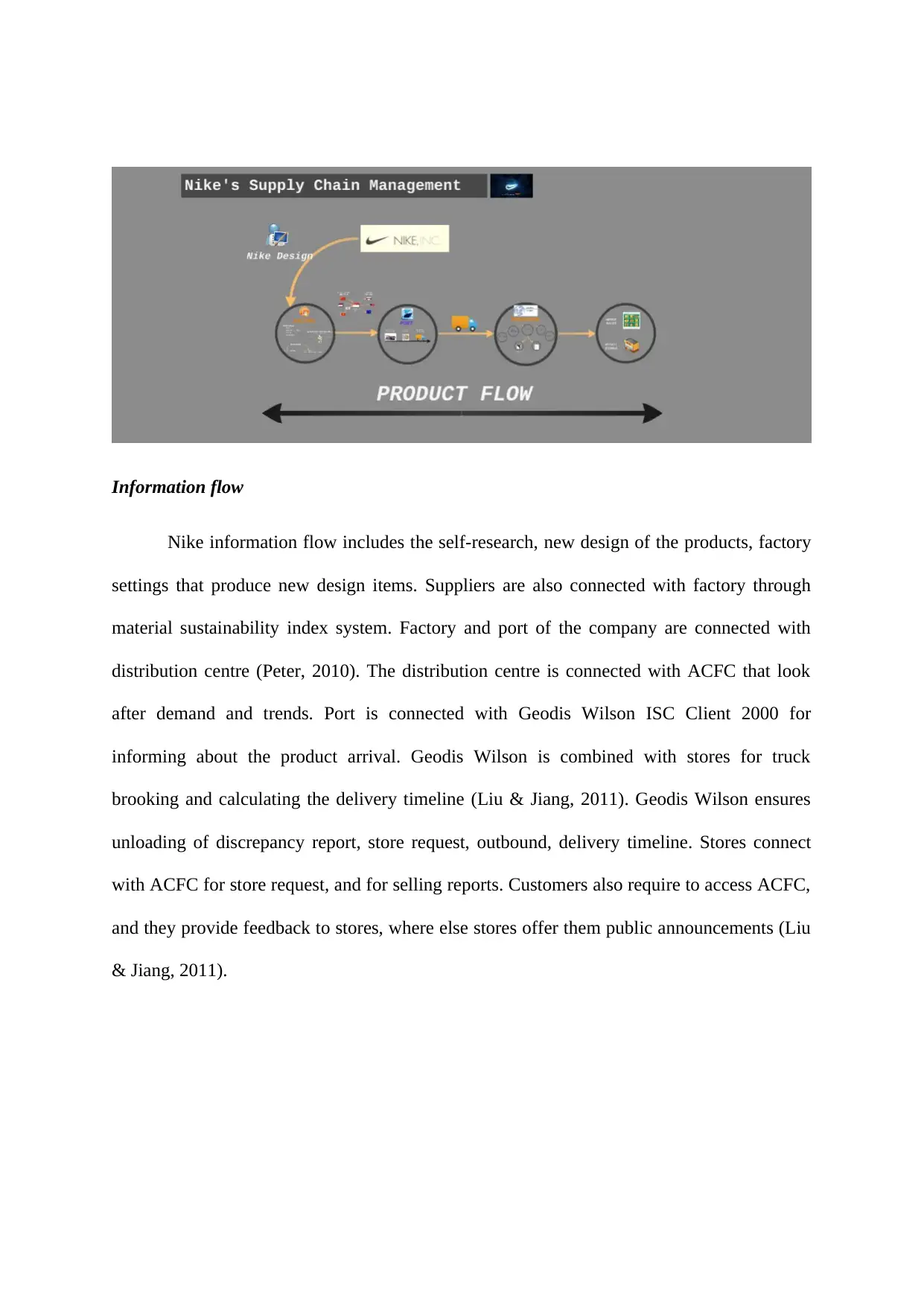
Information flow
Nike information flow includes the self-research, new design of the products, factory
settings that produce new design items. Suppliers are also connected with factory through
material sustainability index system. Factory and port of the company are connected with
distribution centre (Peter, 2010). The distribution centre is connected with ACFC that look
after demand and trends. Port is connected with Geodis Wilson ISC Client 2000 for
informing about the product arrival. Geodis Wilson is combined with stores for truck
brooking and calculating the delivery timeline (Liu & Jiang, 2011). Geodis Wilson ensures
unloading of discrepancy report, store request, outbound, delivery timeline. Stores connect
with ACFC for store request, and for selling reports. Customers also require to access ACFC,
and they provide feedback to stores, where else stores offer them public announcements (Liu
& Jiang, 2011).
Nike information flow includes the self-research, new design of the products, factory
settings that produce new design items. Suppliers are also connected with factory through
material sustainability index system. Factory and port of the company are connected with
distribution centre (Peter, 2010). The distribution centre is connected with ACFC that look
after demand and trends. Port is connected with Geodis Wilson ISC Client 2000 for
informing about the product arrival. Geodis Wilson is combined with stores for truck
brooking and calculating the delivery timeline (Liu & Jiang, 2011). Geodis Wilson ensures
unloading of discrepancy report, store request, outbound, delivery timeline. Stores connect
with ACFC for store request, and for selling reports. Customers also require to access ACFC,
and they provide feedback to stores, where else stores offer them public announcements (Liu
& Jiang, 2011).
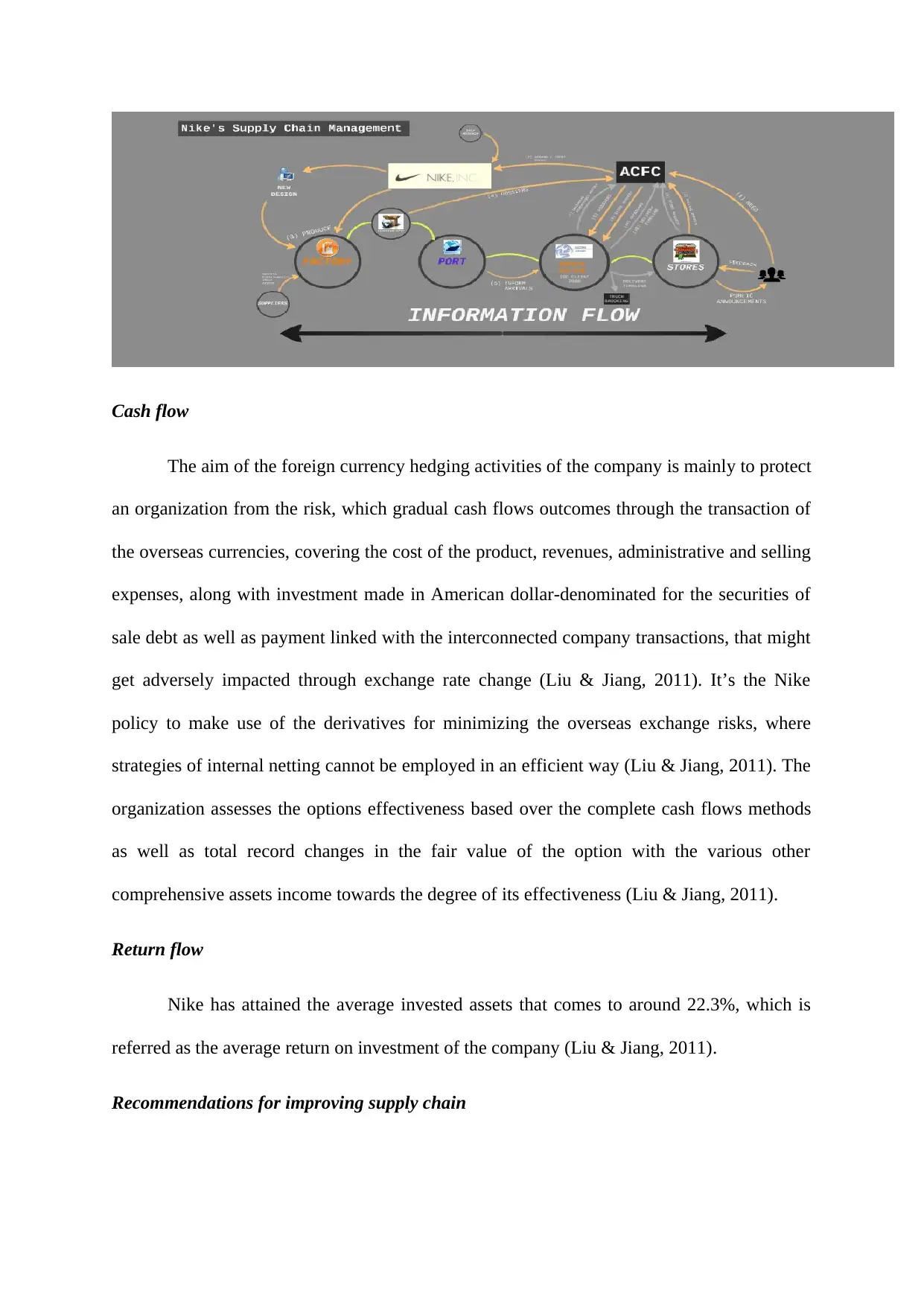
Cash flow
The aim of the foreign currency hedging activities of the company is mainly to protect
an organization from the risk, which gradual cash flows outcomes through the transaction of
the overseas currencies, covering the cost of the product, revenues, administrative and selling
expenses, along with investment made in American dollar-denominated for the securities of
sale debt as well as payment linked with the interconnected company transactions, that might
get adversely impacted through exchange rate change (Liu & Jiang, 2011). It’s the Nike
policy to make use of the derivatives for minimizing the overseas exchange risks, where
strategies of internal netting cannot be employed in an efficient way (Liu & Jiang, 2011). The
organization assesses the options effectiveness based over the complete cash flows methods
as well as total record changes in the fair value of the option with the various other
comprehensive assets income towards the degree of its effectiveness (Liu & Jiang, 2011).
Return flow
Nike has attained the average invested assets that comes to around 22.3%, which is
referred as the average return on investment of the company (Liu & Jiang, 2011).
Recommendations for improving supply chain
The aim of the foreign currency hedging activities of the company is mainly to protect
an organization from the risk, which gradual cash flows outcomes through the transaction of
the overseas currencies, covering the cost of the product, revenues, administrative and selling
expenses, along with investment made in American dollar-denominated for the securities of
sale debt as well as payment linked with the interconnected company transactions, that might
get adversely impacted through exchange rate change (Liu & Jiang, 2011). It’s the Nike
policy to make use of the derivatives for minimizing the overseas exchange risks, where
strategies of internal netting cannot be employed in an efficient way (Liu & Jiang, 2011). The
organization assesses the options effectiveness based over the complete cash flows methods
as well as total record changes in the fair value of the option with the various other
comprehensive assets income towards the degree of its effectiveness (Liu & Jiang, 2011).
Return flow
Nike has attained the average invested assets that comes to around 22.3%, which is
referred as the average return on investment of the company (Liu & Jiang, 2011).
Recommendations for improving supply chain
Secure Best Marks with AI Grader
Need help grading? Try our AI Grader for instant feedback on your assignments.
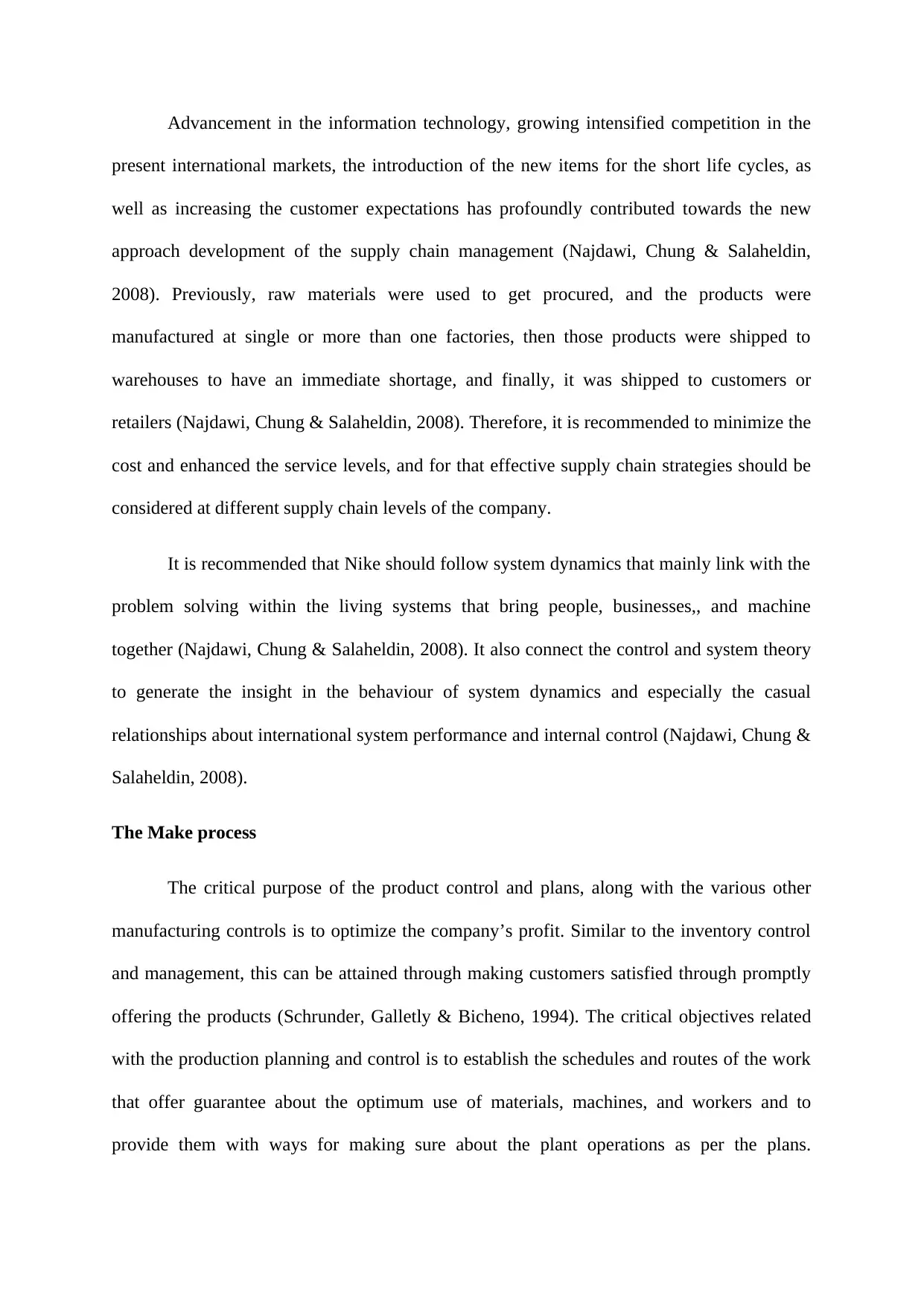
Advancement in the information technology, growing intensified competition in the
present international markets, the introduction of the new items for the short life cycles, as
well as increasing the customer expectations has profoundly contributed towards the new
approach development of the supply chain management (Najdawi, Chung & Salaheldin,
2008). Previously, raw materials were used to get procured, and the products were
manufactured at single or more than one factories, then those products were shipped to
warehouses to have an immediate shortage, and finally, it was shipped to customers or
retailers (Najdawi, Chung & Salaheldin, 2008). Therefore, it is recommended to minimize the
cost and enhanced the service levels, and for that effective supply chain strategies should be
considered at different supply chain levels of the company.
It is recommended that Nike should follow system dynamics that mainly link with the
problem solving within the living systems that bring people, businesses,, and machine
together (Najdawi, Chung & Salaheldin, 2008). It also connect the control and system theory
to generate the insight in the behaviour of system dynamics and especially the casual
relationships about international system performance and internal control (Najdawi, Chung &
Salaheldin, 2008).
The Make process
The critical purpose of the product control and plans, along with the various other
manufacturing controls is to optimize the company’s profit. Similar to the inventory control
and management, this can be attained through making customers satisfied through promptly
offering the products (Schrunder, Galletly & Bicheno, 1994). The critical objectives related
with the production planning and control is to establish the schedules and routes of the work
that offer guarantee about the optimum use of materials, machines, and workers and to
provide them with ways for making sure about the plant operations as per the plans.
present international markets, the introduction of the new items for the short life cycles, as
well as increasing the customer expectations has profoundly contributed towards the new
approach development of the supply chain management (Najdawi, Chung & Salaheldin,
2008). Previously, raw materials were used to get procured, and the products were
manufactured at single or more than one factories, then those products were shipped to
warehouses to have an immediate shortage, and finally, it was shipped to customers or
retailers (Najdawi, Chung & Salaheldin, 2008). Therefore, it is recommended to minimize the
cost and enhanced the service levels, and for that effective supply chain strategies should be
considered at different supply chain levels of the company.
It is recommended that Nike should follow system dynamics that mainly link with the
problem solving within the living systems that bring people, businesses,, and machine
together (Najdawi, Chung & Salaheldin, 2008). It also connect the control and system theory
to generate the insight in the behaviour of system dynamics and especially the casual
relationships about international system performance and internal control (Najdawi, Chung &
Salaheldin, 2008).
The Make process
The critical purpose of the product control and plans, along with the various other
manufacturing controls is to optimize the company’s profit. Similar to the inventory control
and management, this can be attained through making customers satisfied through promptly
offering the products (Schrunder, Galletly & Bicheno, 1994). The critical objectives related
with the production planning and control is to establish the schedules and routes of the work
that offer guarantee about the optimum use of materials, machines, and workers and to
provide them with ways for making sure about the plant operations as per the plans.
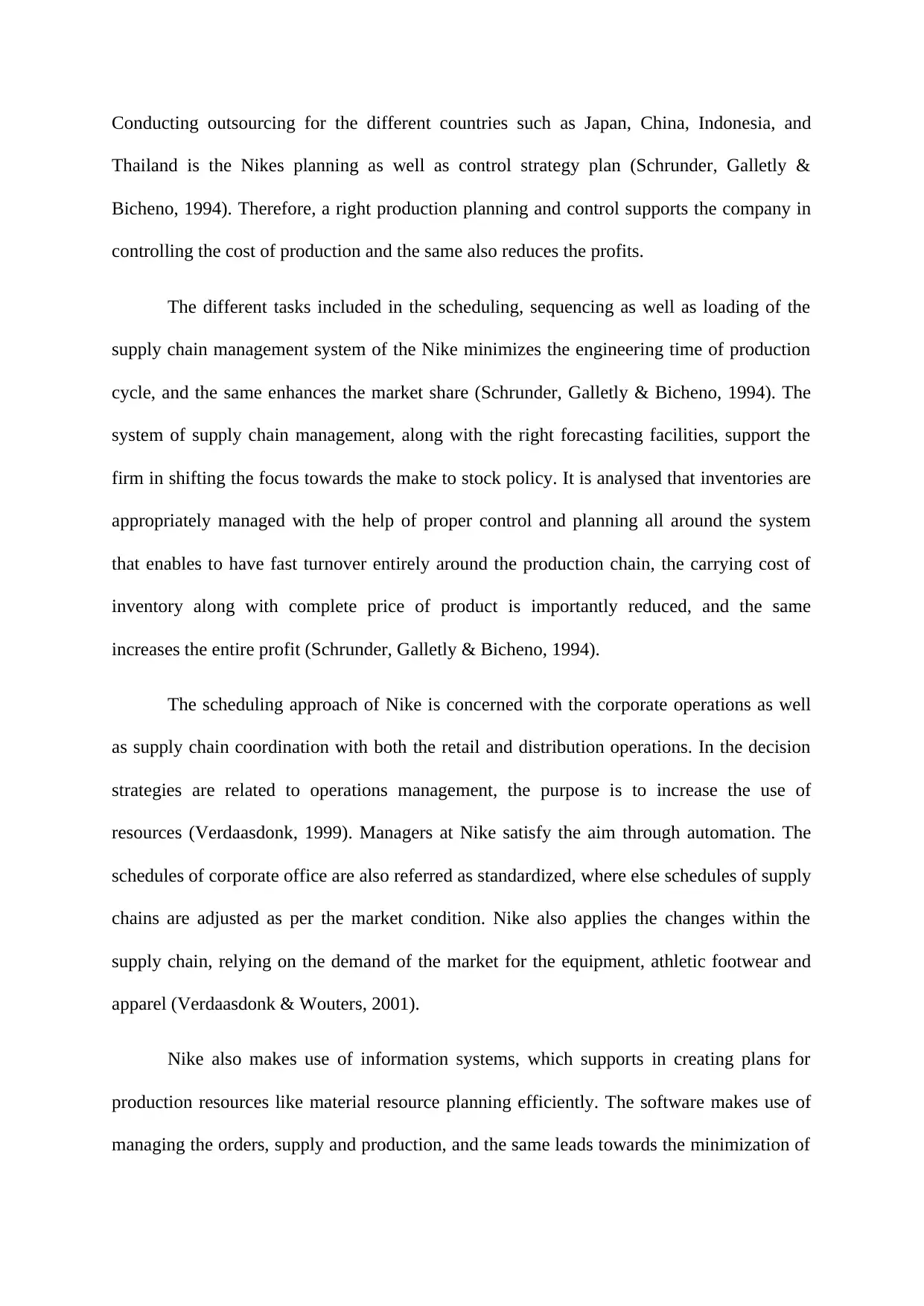
Conducting outsourcing for the different countries such as Japan, China, Indonesia, and
Thailand is the Nikes planning as well as control strategy plan (Schrunder, Galletly &
Bicheno, 1994). Therefore, a right production planning and control supports the company in
controlling the cost of production and the same also reduces the profits.
The different tasks included in the scheduling, sequencing as well as loading of the
supply chain management system of the Nike minimizes the engineering time of production
cycle, and the same enhances the market share (Schrunder, Galletly & Bicheno, 1994). The
system of supply chain management, along with the right forecasting facilities, support the
firm in shifting the focus towards the make to stock policy. It is analysed that inventories are
appropriately managed with the help of proper control and planning all around the system
that enables to have fast turnover entirely around the production chain, the carrying cost of
inventory along with complete price of product is importantly reduced, and the same
increases the entire profit (Schrunder, Galletly & Bicheno, 1994).
The scheduling approach of Nike is concerned with the corporate operations as well
as supply chain coordination with both the retail and distribution operations. In the decision
strategies are related to operations management, the purpose is to increase the use of
resources (Verdaasdonk, 1999). Managers at Nike satisfy the aim through automation. The
schedules of corporate office are also referred as standardized, where else schedules of supply
chains are adjusted as per the market condition. Nike also applies the changes within the
supply chain, relying on the demand of the market for the equipment, athletic footwear and
apparel (Verdaasdonk & Wouters, 2001).
Nike also makes use of information systems, which supports in creating plans for
production resources like material resource planning efficiently. The software makes use of
managing the orders, supply and production, and the same leads towards the minimization of
Thailand is the Nikes planning as well as control strategy plan (Schrunder, Galletly &
Bicheno, 1994). Therefore, a right production planning and control supports the company in
controlling the cost of production and the same also reduces the profits.
The different tasks included in the scheduling, sequencing as well as loading of the
supply chain management system of the Nike minimizes the engineering time of production
cycle, and the same enhances the market share (Schrunder, Galletly & Bicheno, 1994). The
system of supply chain management, along with the right forecasting facilities, support the
firm in shifting the focus towards the make to stock policy. It is analysed that inventories are
appropriately managed with the help of proper control and planning all around the system
that enables to have fast turnover entirely around the production chain, the carrying cost of
inventory along with complete price of product is importantly reduced, and the same
increases the entire profit (Schrunder, Galletly & Bicheno, 1994).
The scheduling approach of Nike is concerned with the corporate operations as well
as supply chain coordination with both the retail and distribution operations. In the decision
strategies are related to operations management, the purpose is to increase the use of
resources (Verdaasdonk, 1999). Managers at Nike satisfy the aim through automation. The
schedules of corporate office are also referred as standardized, where else schedules of supply
chains are adjusted as per the market condition. Nike also applies the changes within the
supply chain, relying on the demand of the market for the equipment, athletic footwear and
apparel (Verdaasdonk & Wouters, 2001).
Nike also makes use of information systems, which supports in creating plans for
production resources like material resource planning efficiently. The software makes use of
managing the orders, supply and production, and the same leads towards the minimization of
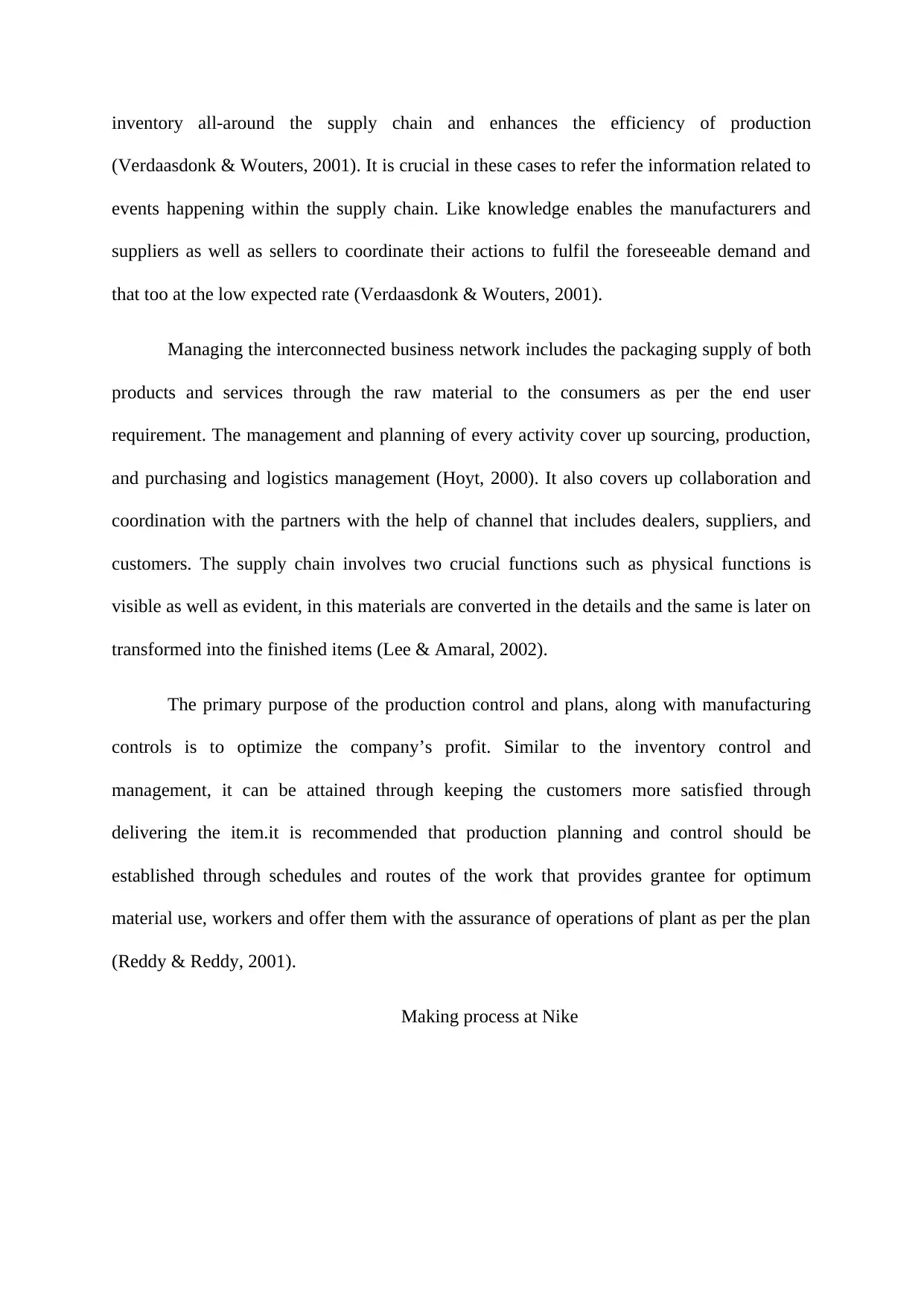
inventory all-around the supply chain and enhances the efficiency of production
(Verdaasdonk & Wouters, 2001). It is crucial in these cases to refer the information related to
events happening within the supply chain. Like knowledge enables the manufacturers and
suppliers as well as sellers to coordinate their actions to fulfil the foreseeable demand and
that too at the low expected rate (Verdaasdonk & Wouters, 2001).
Managing the interconnected business network includes the packaging supply of both
products and services through the raw material to the consumers as per the end user
requirement. The management and planning of every activity cover up sourcing, production,
and purchasing and logistics management (Hoyt, 2000). It also covers up collaboration and
coordination with the partners with the help of channel that includes dealers, suppliers, and
customers. The supply chain involves two crucial functions such as physical functions is
visible as well as evident, in this materials are converted in the details and the same is later on
transformed into the finished items (Lee & Amaral, 2002).
The primary purpose of the production control and plans, along with manufacturing
controls is to optimize the company’s profit. Similar to the inventory control and
management, it can be attained through keeping the customers more satisfied through
delivering the item.it is recommended that production planning and control should be
established through schedules and routes of the work that provides grantee for optimum
material use, workers and offer them with the assurance of operations of plant as per the plan
(Reddy & Reddy, 2001).
Making process at Nike
(Verdaasdonk & Wouters, 2001). It is crucial in these cases to refer the information related to
events happening within the supply chain. Like knowledge enables the manufacturers and
suppliers as well as sellers to coordinate their actions to fulfil the foreseeable demand and
that too at the low expected rate (Verdaasdonk & Wouters, 2001).
Managing the interconnected business network includes the packaging supply of both
products and services through the raw material to the consumers as per the end user
requirement. The management and planning of every activity cover up sourcing, production,
and purchasing and logistics management (Hoyt, 2000). It also covers up collaboration and
coordination with the partners with the help of channel that includes dealers, suppliers, and
customers. The supply chain involves two crucial functions such as physical functions is
visible as well as evident, in this materials are converted in the details and the same is later on
transformed into the finished items (Lee & Amaral, 2002).
The primary purpose of the production control and plans, along with manufacturing
controls is to optimize the company’s profit. Similar to the inventory control and
management, it can be attained through keeping the customers more satisfied through
delivering the item.it is recommended that production planning and control should be
established through schedules and routes of the work that provides grantee for optimum
material use, workers and offer them with the assurance of operations of plant as per the plan
(Reddy & Reddy, 2001).
Making process at Nike
Paraphrase This Document
Need a fresh take? Get an instant paraphrase of this document with our AI Paraphraser
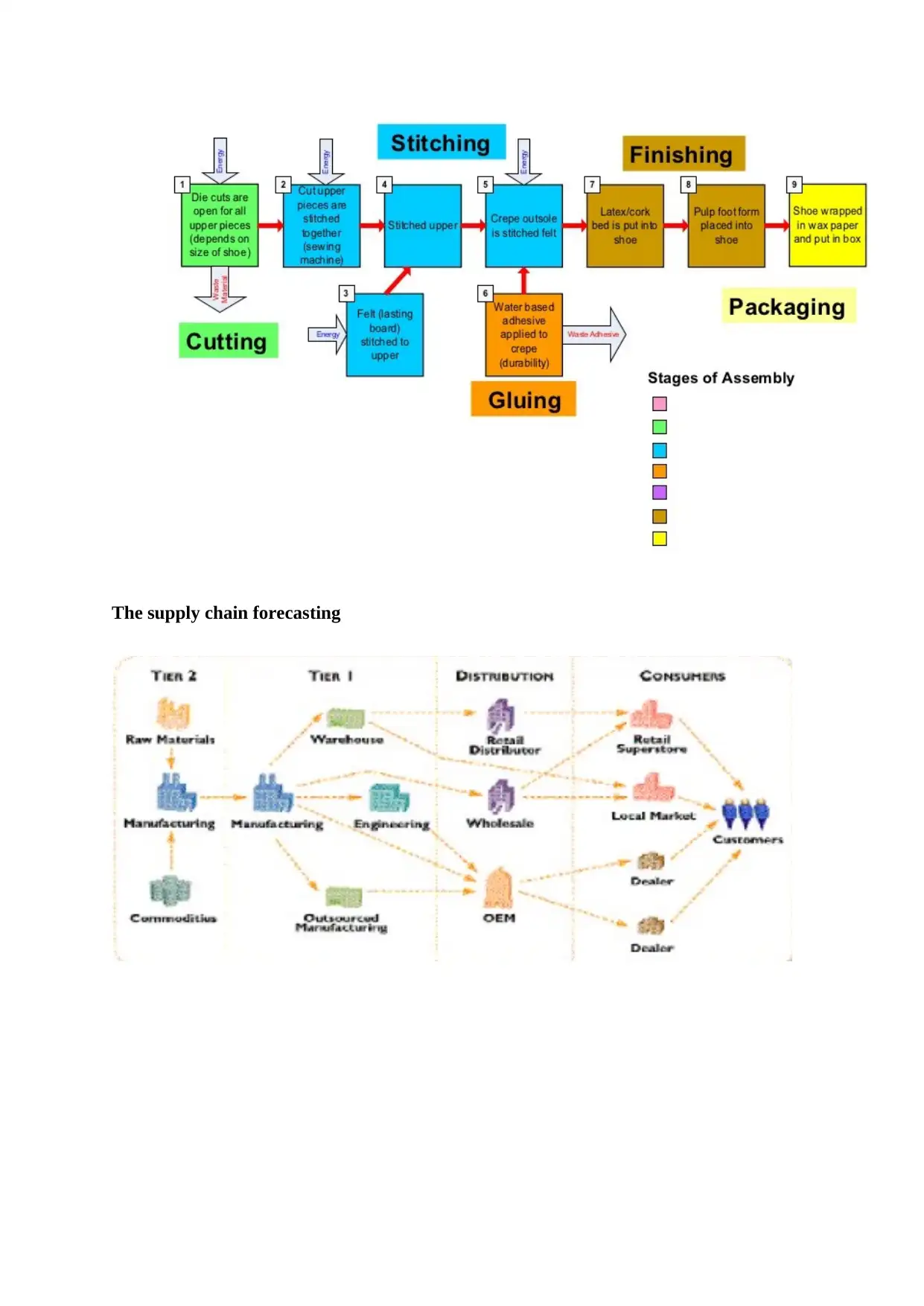
The supply chain forecasting
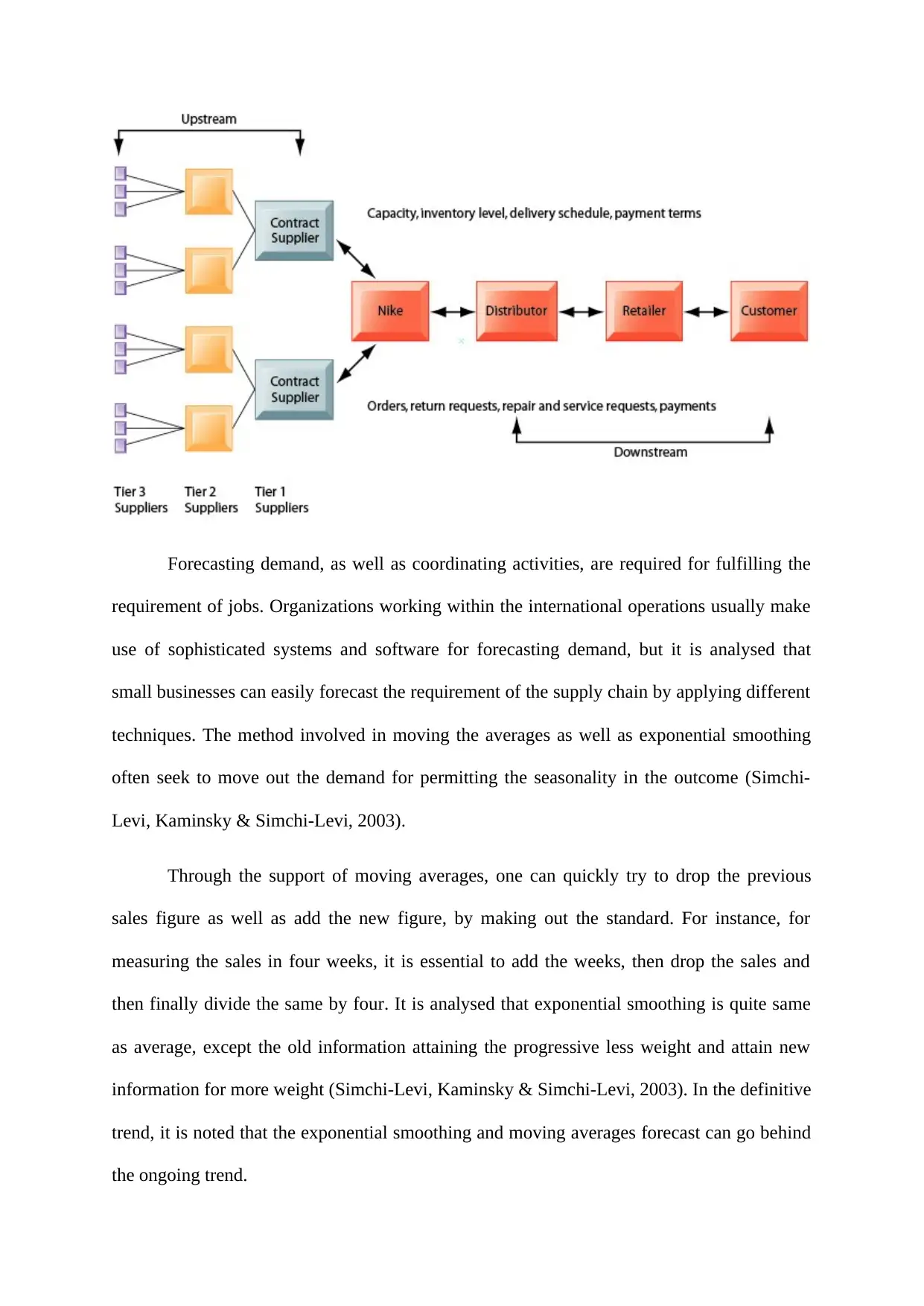
Forecasting demand, as well as coordinating activities, are required for fulfilling the
requirement of jobs. Organizations working within the international operations usually make
use of sophisticated systems and software for forecasting demand, but it is analysed that
small businesses can easily forecast the requirement of the supply chain by applying different
techniques. The method involved in moving the averages as well as exponential smoothing
often seek to move out the demand for permitting the seasonality in the outcome (Simchi-
Levi, Kaminsky & Simchi-Levi, 2003).
Through the support of moving averages, one can quickly try to drop the previous
sales figure as well as add the new figure, by making out the standard. For instance, for
measuring the sales in four weeks, it is essential to add the weeks, then drop the sales and
then finally divide the same by four. It is analysed that exponential smoothing is quite same
as average, except the old information attaining the progressive less weight and attain new
information for more weight (Simchi-Levi, Kaminsky & Simchi-Levi, 2003). In the definitive
trend, it is noted that the exponential smoothing and moving averages forecast can go behind
the ongoing trend.
requirement of jobs. Organizations working within the international operations usually make
use of sophisticated systems and software for forecasting demand, but it is analysed that
small businesses can easily forecast the requirement of the supply chain by applying different
techniques. The method involved in moving the averages as well as exponential smoothing
often seek to move out the demand for permitting the seasonality in the outcome (Simchi-
Levi, Kaminsky & Simchi-Levi, 2003).
Through the support of moving averages, one can quickly try to drop the previous
sales figure as well as add the new figure, by making out the standard. For instance, for
measuring the sales in four weeks, it is essential to add the weeks, then drop the sales and
then finally divide the same by four. It is analysed that exponential smoothing is quite same
as average, except the old information attaining the progressive less weight and attain new
information for more weight (Simchi-Levi, Kaminsky & Simchi-Levi, 2003). In the definitive
trend, it is noted that the exponential smoothing and moving averages forecast can go behind
the ongoing trend.
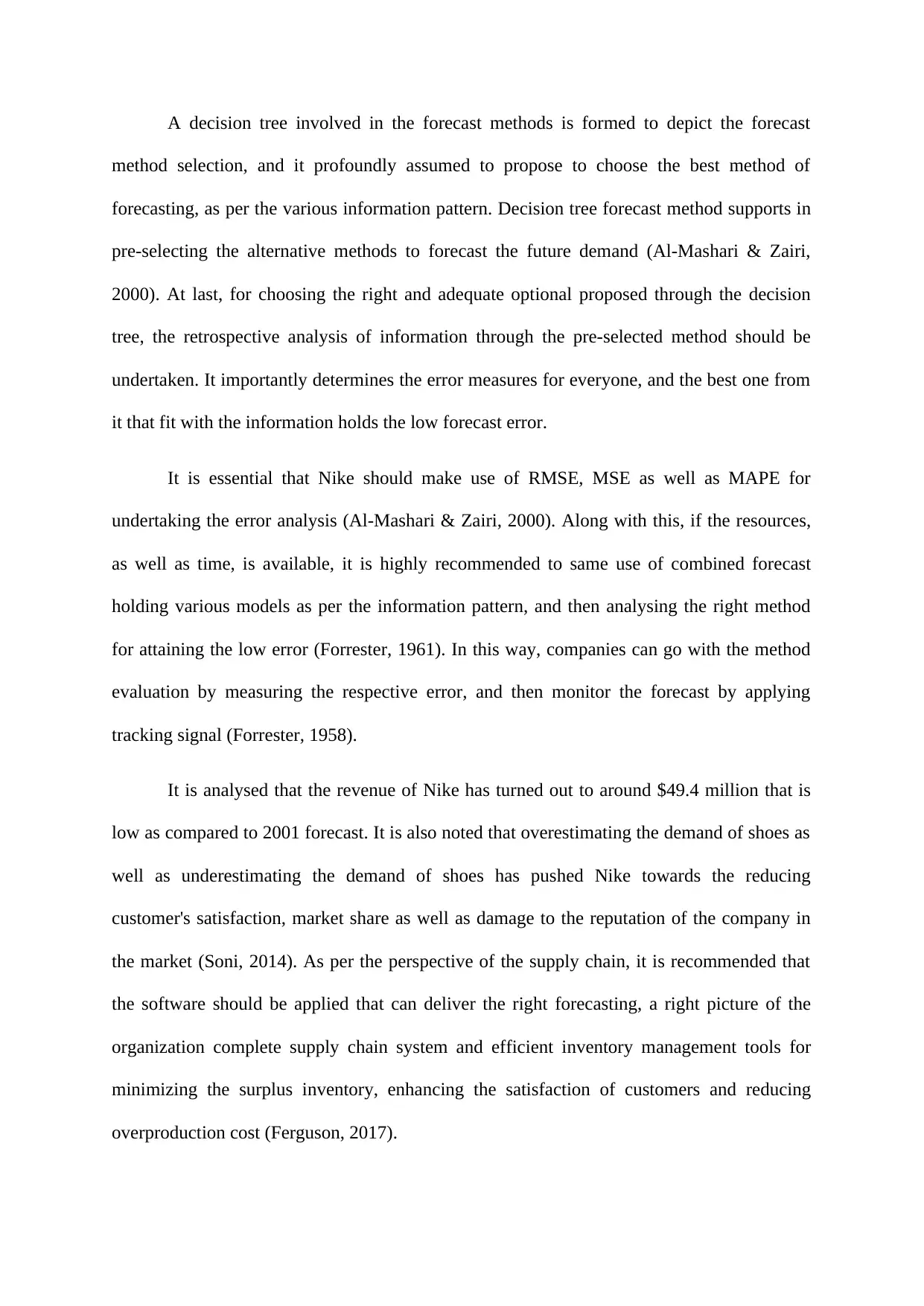
A decision tree involved in the forecast methods is formed to depict the forecast
method selection, and it profoundly assumed to propose to choose the best method of
forecasting, as per the various information pattern. Decision tree forecast method supports in
pre-selecting the alternative methods to forecast the future demand (Al-Mashari & Zairi,
2000). At last, for choosing the right and adequate optional proposed through the decision
tree, the retrospective analysis of information through the pre-selected method should be
undertaken. It importantly determines the error measures for everyone, and the best one from
it that fit with the information holds the low forecast error.
It is essential that Nike should make use of RMSE, MSE as well as MAPE for
undertaking the error analysis (Al-Mashari & Zairi, 2000). Along with this, if the resources,
as well as time, is available, it is highly recommended to same use of combined forecast
holding various models as per the information pattern, and then analysing the right method
for attaining the low error (Forrester, 1961). In this way, companies can go with the method
evaluation by measuring the respective error, and then monitor the forecast by applying
tracking signal (Forrester, 1958).
It is analysed that the revenue of Nike has turned out to around $49.4 million that is
low as compared to 2001 forecast. It is also noted that overestimating the demand of shoes as
well as underestimating the demand of shoes has pushed Nike towards the reducing
customer's satisfaction, market share as well as damage to the reputation of the company in
the market (Soni, 2014). As per the perspective of the supply chain, it is recommended that
the software should be applied that can deliver the right forecasting, a right picture of the
organization complete supply chain system and efficient inventory management tools for
minimizing the surplus inventory, enhancing the satisfaction of customers and reducing
overproduction cost (Ferguson, 2017).
method selection, and it profoundly assumed to propose to choose the best method of
forecasting, as per the various information pattern. Decision tree forecast method supports in
pre-selecting the alternative methods to forecast the future demand (Al-Mashari & Zairi,
2000). At last, for choosing the right and adequate optional proposed through the decision
tree, the retrospective analysis of information through the pre-selected method should be
undertaken. It importantly determines the error measures for everyone, and the best one from
it that fit with the information holds the low forecast error.
It is essential that Nike should make use of RMSE, MSE as well as MAPE for
undertaking the error analysis (Al-Mashari & Zairi, 2000). Along with this, if the resources,
as well as time, is available, it is highly recommended to same use of combined forecast
holding various models as per the information pattern, and then analysing the right method
for attaining the low error (Forrester, 1961). In this way, companies can go with the method
evaluation by measuring the respective error, and then monitor the forecast by applying
tracking signal (Forrester, 1958).
It is analysed that the revenue of Nike has turned out to around $49.4 million that is
low as compared to 2001 forecast. It is also noted that overestimating the demand of shoes as
well as underestimating the demand of shoes has pushed Nike towards the reducing
customer's satisfaction, market share as well as damage to the reputation of the company in
the market (Soni, 2014). As per the perspective of the supply chain, it is recommended that
the software should be applied that can deliver the right forecasting, a right picture of the
organization complete supply chain system and efficient inventory management tools for
minimizing the surplus inventory, enhancing the satisfaction of customers and reducing
overproduction cost (Ferguson, 2017).
Secure Best Marks with AI Grader
Need help grading? Try our AI Grader for instant feedback on your assignments.
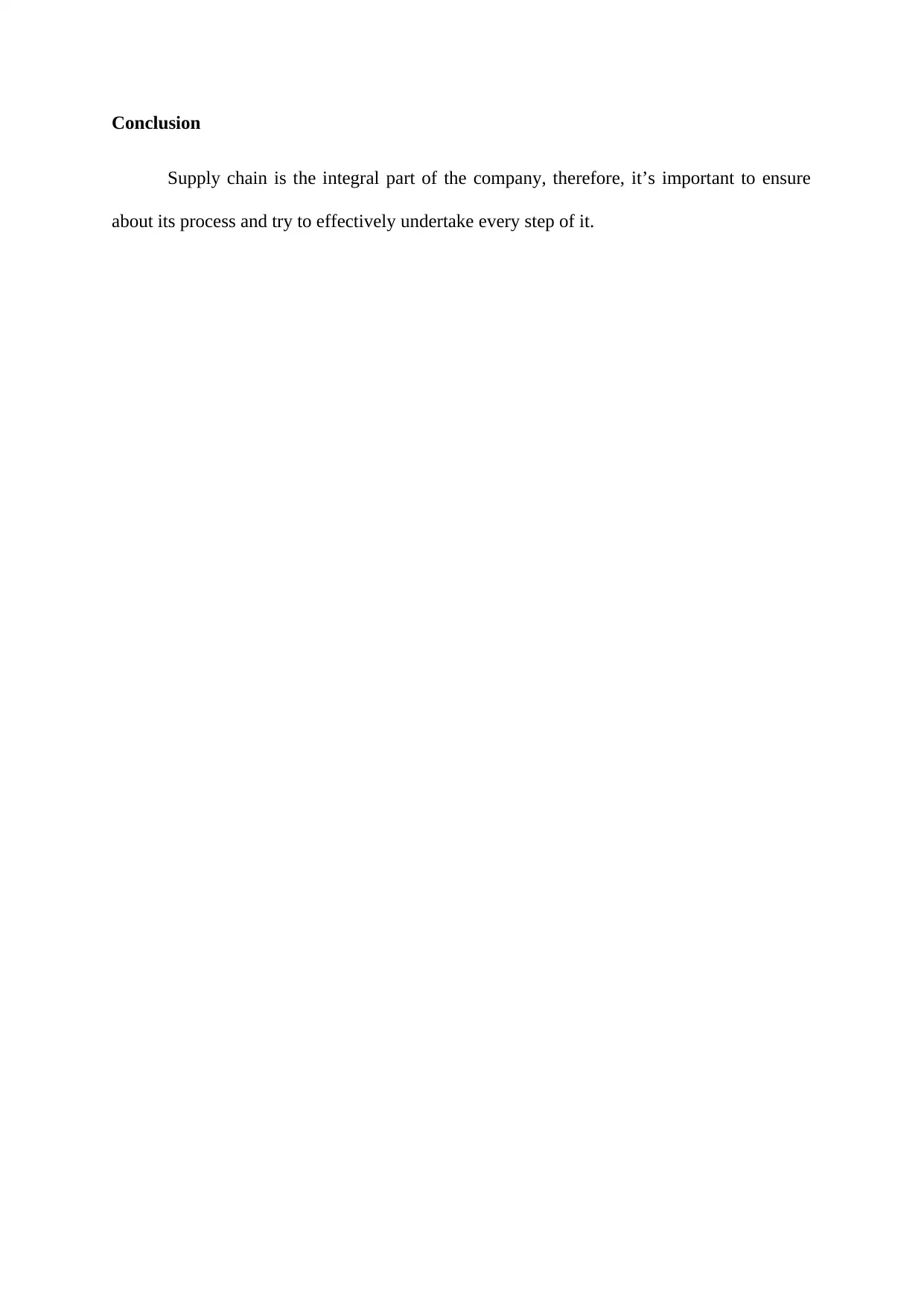
Conclusion
Supply chain is the integral part of the company, therefore, it’s important to ensure
about its process and try to effectively undertake every step of it.
Supply chain is the integral part of the company, therefore, it’s important to ensure
about its process and try to effectively undertake every step of it.
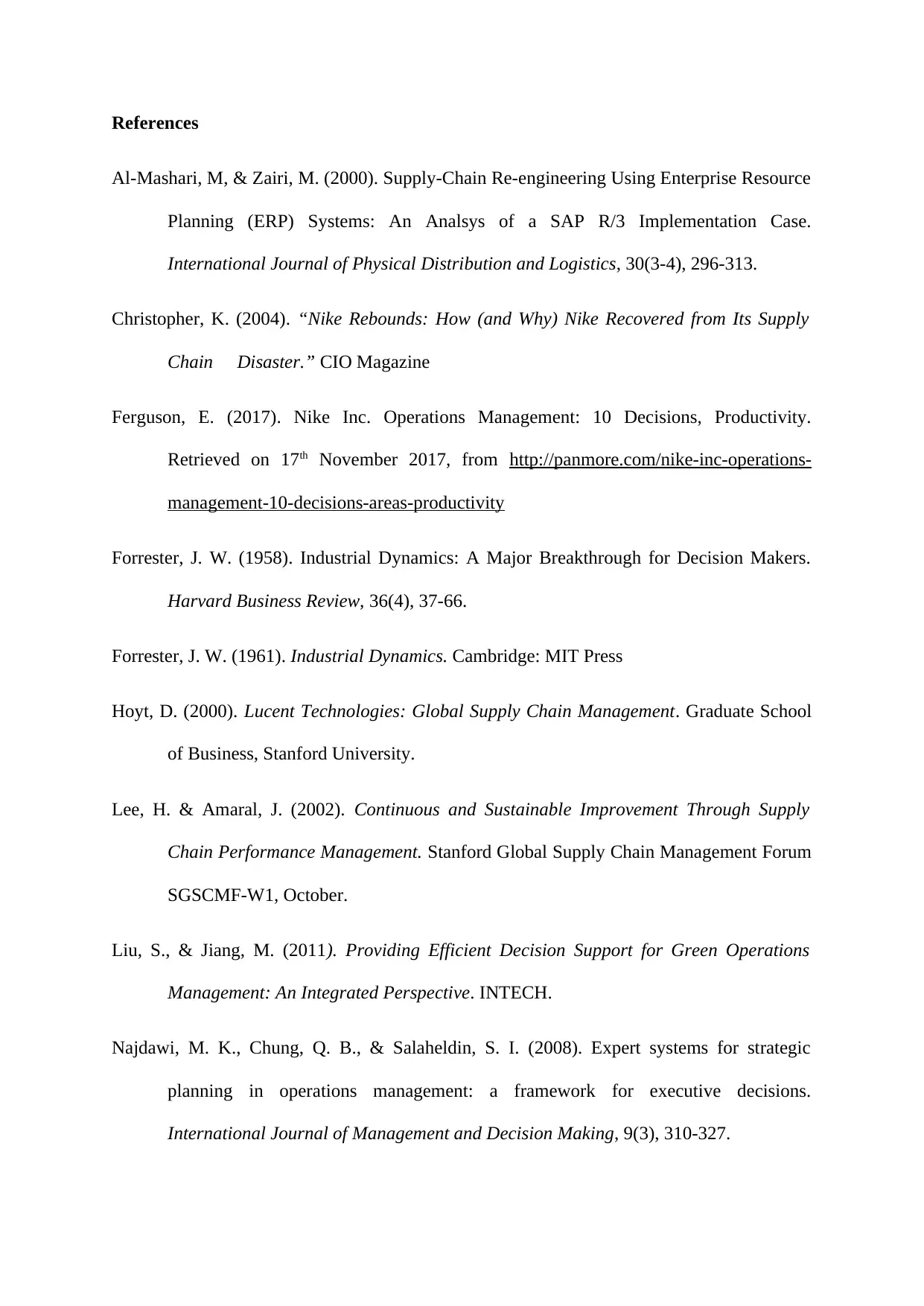
References
Al-Mashari, M, & Zairi, M. (2000). Supply-Chain Re-engineering Using Enterprise Resource
Planning (ERP) Systems: An Analsys of a SAP R/3 Implementation Case.
International Journal of Physical Distribution and Logistics, 30(3-4), 296-313.
Christopher, K. (2004). “Nike Rebounds: How (and Why) Nike Recovered from Its Supply
Chain Disaster.” CIO Magazine
Ferguson, E. (2017). Nike Inc. Operations Management: 10 Decisions, Productivity.
Retrieved on 17th November 2017, from http://panmore.com/nike-inc-operations-
management-10-decisions-areas-productivity
Forrester, J. W. (1958). Industrial Dynamics: A Major Breakthrough for Decision Makers.
Harvard Business Review, 36(4), 37-66.
Forrester, J. W. (1961). Industrial Dynamics. Cambridge: MIT Press
Hoyt, D. (2000). Lucent Technologies: Global Supply Chain Management. Graduate School
of Business, Stanford University.
Lee, H. & Amaral, J. (2002). Continuous and Sustainable Improvement Through Supply
Chain Performance Management. Stanford Global Supply Chain Management Forum
SGSCMF-W1, October.
Liu, S., & Jiang, M. (2011). Providing Efficient Decision Support for Green Operations
Management: An Integrated Perspective. INTECH.
Najdawi, M. K., Chung, Q. B., & Salaheldin, S. I. (2008). Expert systems for strategic
planning in operations management: a framework for executive decisions.
International Journal of Management and Decision Making, 9(3), 310-327.
Al-Mashari, M, & Zairi, M. (2000). Supply-Chain Re-engineering Using Enterprise Resource
Planning (ERP) Systems: An Analsys of a SAP R/3 Implementation Case.
International Journal of Physical Distribution and Logistics, 30(3-4), 296-313.
Christopher, K. (2004). “Nike Rebounds: How (and Why) Nike Recovered from Its Supply
Chain Disaster.” CIO Magazine
Ferguson, E. (2017). Nike Inc. Operations Management: 10 Decisions, Productivity.
Retrieved on 17th November 2017, from http://panmore.com/nike-inc-operations-
management-10-decisions-areas-productivity
Forrester, J. W. (1958). Industrial Dynamics: A Major Breakthrough for Decision Makers.
Harvard Business Review, 36(4), 37-66.
Forrester, J. W. (1961). Industrial Dynamics. Cambridge: MIT Press
Hoyt, D. (2000). Lucent Technologies: Global Supply Chain Management. Graduate School
of Business, Stanford University.
Lee, H. & Amaral, J. (2002). Continuous and Sustainable Improvement Through Supply
Chain Performance Management. Stanford Global Supply Chain Management Forum
SGSCMF-W1, October.
Liu, S., & Jiang, M. (2011). Providing Efficient Decision Support for Green Operations
Management: An Integrated Perspective. INTECH.
Najdawi, M. K., Chung, Q. B., & Salaheldin, S. I. (2008). Expert systems for strategic
planning in operations management: a framework for executive decisions.
International Journal of Management and Decision Making, 9(3), 310-327.
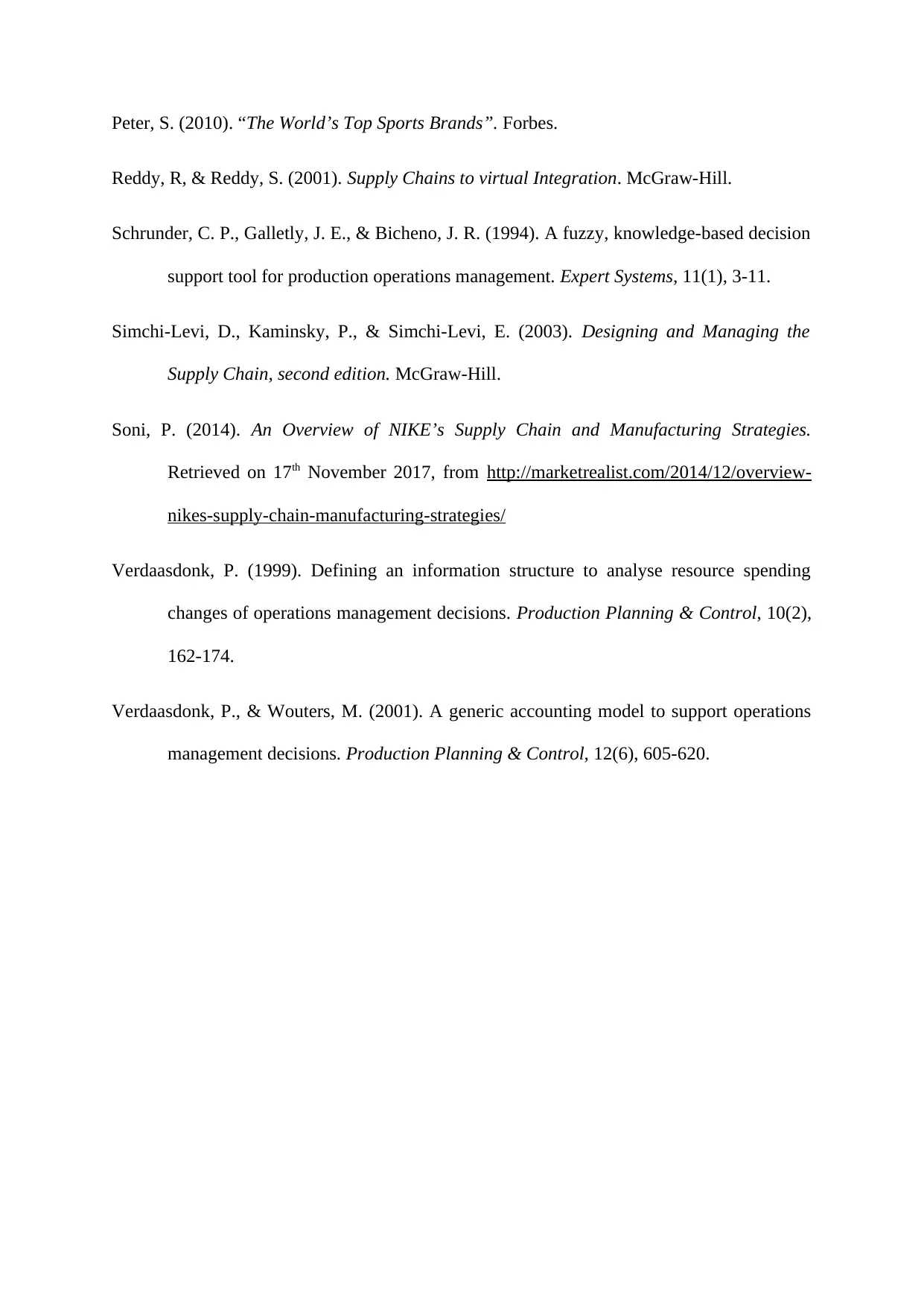
Peter, S. (2010). “The World’s Top Sports Brands”. Forbes.
Reddy, R, & Reddy, S. (2001). Supply Chains to virtual Integration. McGraw-Hill.
Schrunder, C. P., Galletly, J. E., & Bicheno, J. R. (1994). A fuzzy, knowledge‐based decision
support tool for production operations management. Expert Systems, 11(1), 3-11.
Simchi-Levi, D., Kaminsky, P., & Simchi-Levi, E. (2003). Designing and Managing the
Supply Chain, second edition. McGraw-Hill.
Soni, P. (2014). An Overview of NIKE’s Supply Chain and Manufacturing Strategies.
Retrieved on 17th November 2017, from http://marketrealist.com/2014/12/overview-
nikes-supply-chain-manufacturing-strategies/
Verdaasdonk, P. (1999). Defining an information structure to analyse resource spending
changes of operations management decisions. Production Planning & Control, 10(2),
162-174.
Verdaasdonk, P., & Wouters, M. (2001). A generic accounting model to support operations
management decisions. Production Planning & Control, 12(6), 605-620.
Reddy, R, & Reddy, S. (2001). Supply Chains to virtual Integration. McGraw-Hill.
Schrunder, C. P., Galletly, J. E., & Bicheno, J. R. (1994). A fuzzy, knowledge‐based decision
support tool for production operations management. Expert Systems, 11(1), 3-11.
Simchi-Levi, D., Kaminsky, P., & Simchi-Levi, E. (2003). Designing and Managing the
Supply Chain, second edition. McGraw-Hill.
Soni, P. (2014). An Overview of NIKE’s Supply Chain and Manufacturing Strategies.
Retrieved on 17th November 2017, from http://marketrealist.com/2014/12/overview-
nikes-supply-chain-manufacturing-strategies/
Verdaasdonk, P. (1999). Defining an information structure to analyse resource spending
changes of operations management decisions. Production Planning & Control, 10(2),
162-174.
Verdaasdonk, P., & Wouters, M. (2001). A generic accounting model to support operations
management decisions. Production Planning & Control, 12(6), 605-620.
1 out of 13
Your All-in-One AI-Powered Toolkit for Academic Success.
+13062052269
info@desklib.com
Available 24*7 on WhatsApp / Email
![[object Object]](/_next/static/media/star-bottom.7253800d.svg)
Unlock your academic potential
© 2024 | Zucol Services PVT LTD | All rights reserved.



